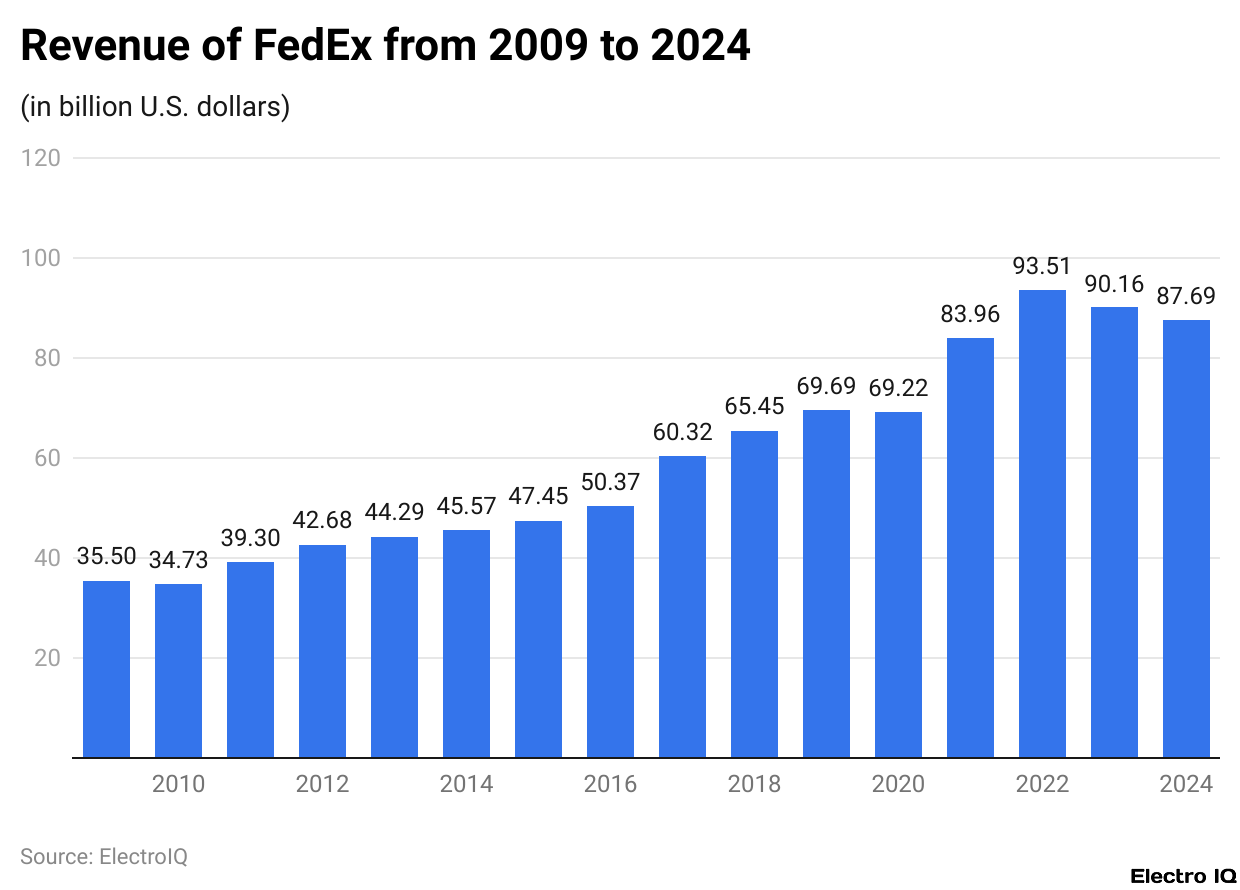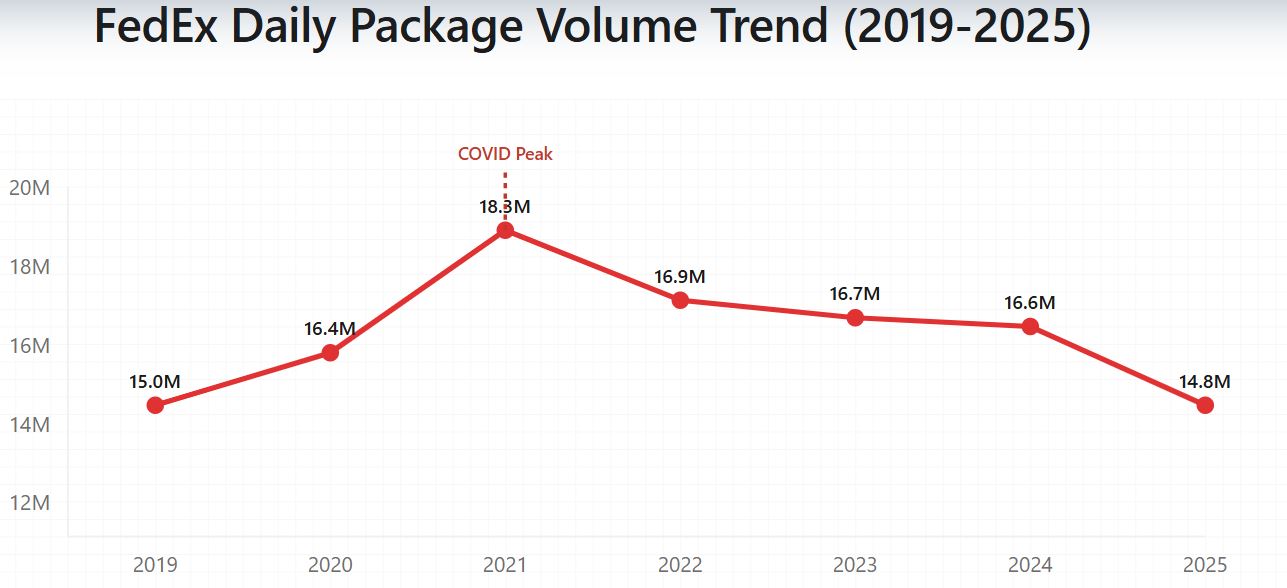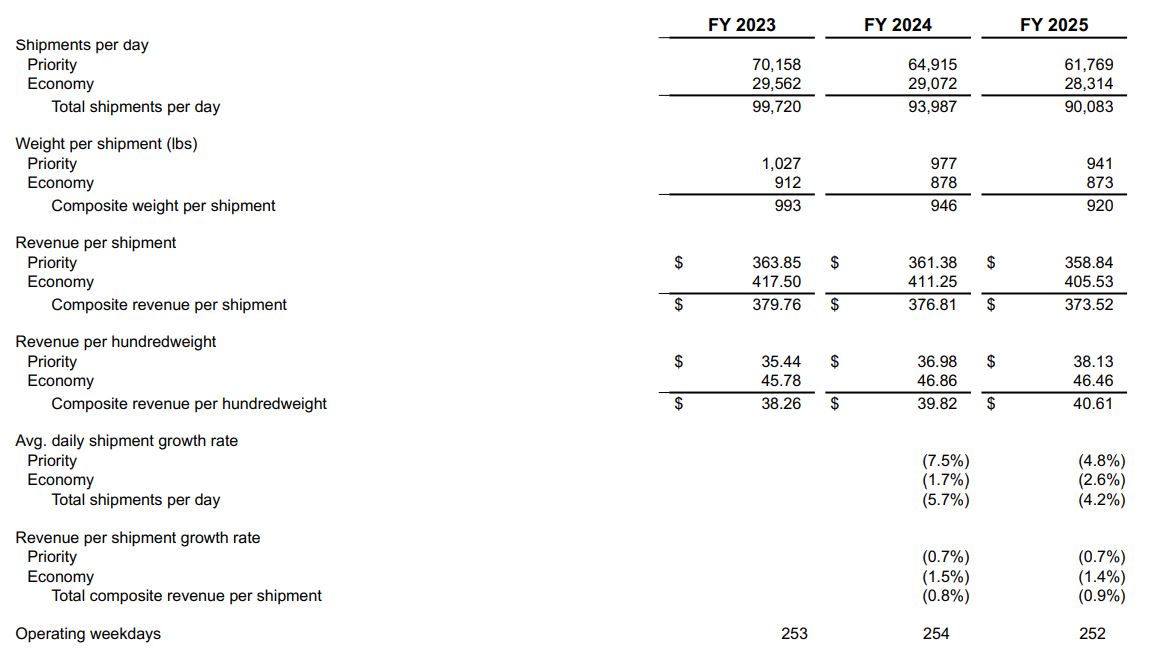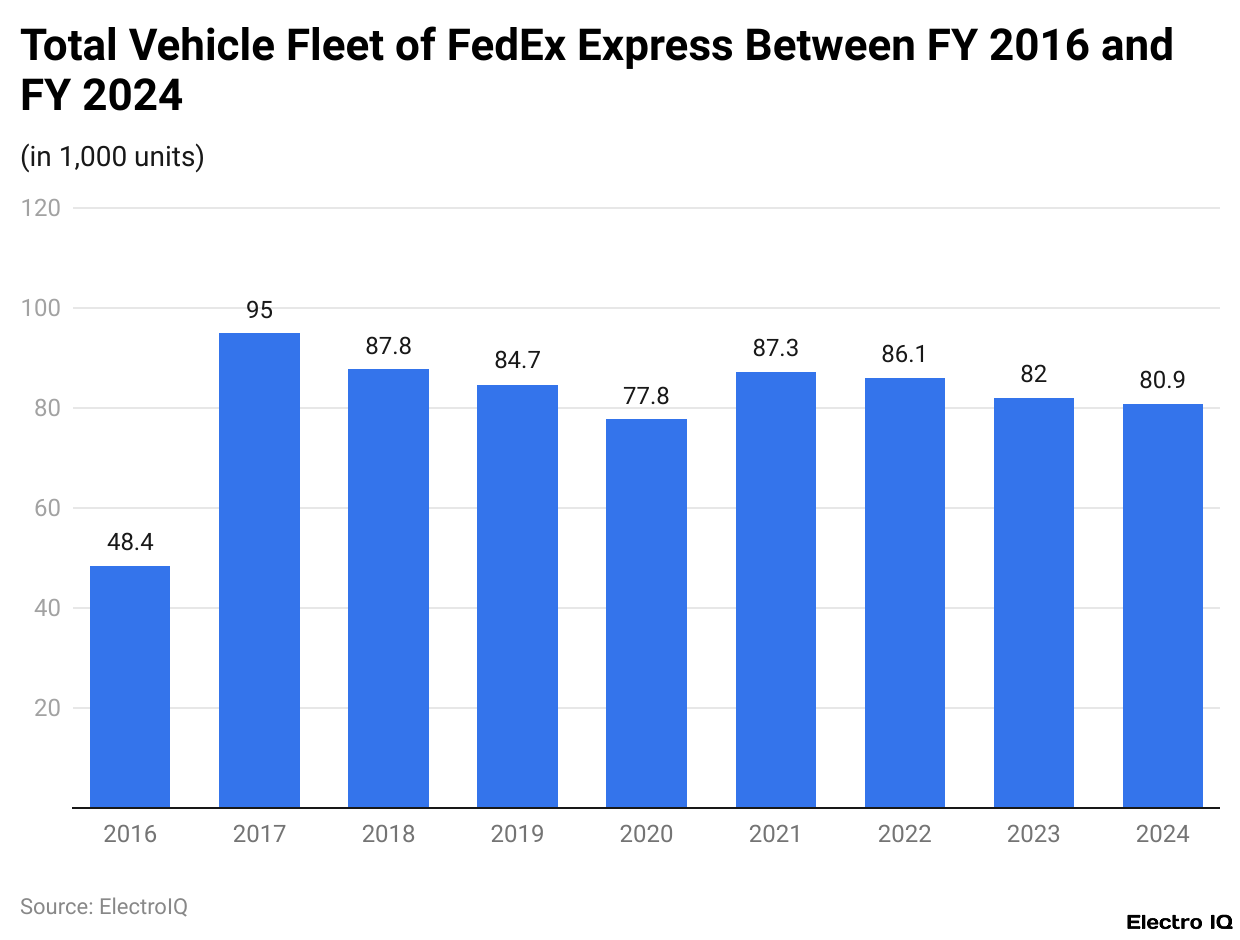Fedex Statistics And Facts – By Revenue, Operations, Capital Expenditure, Packaging (2025)
Updated · Sep 24, 2025

Table of Contents
Introduction
FedEx Statistics: FedEx somehow grew from a courier company to the global logistics powerhouse that keeps the world moving. Starting life in Memphis back in 1998, FedEx has been a cornerstone in the way businesses and consumers interact, generating nearly US$88 billion in revenue by 2024. Balancing speed, scale, and precision are some big words to describe an extensive network of planes, trucks, and technology, delivering millions of packages every day.
Yet, beneath all the numbers, the stories of changing trends take center stage: e-commerce soaring, cost constraints tightening, changing customer trends, and the workforce moving it all. Let’s get into unfolding FedEx statistics worldwide havoc.
Editor’s Choice
- FedEx made nearly US$88 billion in revenues in 2024, placing it among the top five logistics companies in the U.S.
- Fuel prices nosedived from nearly US$5.9 billion in 2023 to US$3.8 billion in 2025, really making efficiency shine.
- Total operating income really hit a high in 2024 at US$5.6 billion, but then dropped to US$5.2 billion in 2025, due to freight weakness.
- Capital expenditure dropped from US$6.2 billion in 2023 to a slim US$4.1 billion in 2025, a sign of tightening cost control.
- FedEx package revenue overall grew from US$67.2 billion in 2023 to US$68.5 billion in 2025.
- Ground deliveries in the U.S. were rising steadily to gain nearly US$34 billion in 2025, with international economy shipments soaring to US$5.9 billion.
- International priority revenues declined from US$10.9 billion in 2023 to US$8.7 billion in 2025, indicating that clients were favouring cheaper services.
- Parcel volumes rose to an all-time high of around 18.3 million in 2021 but fell to about 14.8 million (U.S.) / 17.1 million (global) by 2025 — roughly 10% below the pandemic highs.
- FedEx Freight shipments on a daily basis fell from 99,700 in 2023 to 90,000 in 2025, with Priority shipments experiencing the fastest decrease.
- In 2025, revenue per hundredweight improved marginally to US$40.61, notwithstanding shrinking shipment counts.
- FedEx Express’s vehicle fleet, once peaking at 95,000 in 2017, dwindled down to about 82,000 in 2023 with the aid of a strong freighter fleet of 700.
- Around 70% of FedEx employees earn between US$25,000 and US$40,000, with 3% earning between US$60,000 and US$100,000.
- More pay applies to specialised titles: Lead consultants average US$86,495, senior technologists US$58,929, and operations managers US$55,130.
General Facts
- In January 1998, the company came into existence, thereby establishing itself as one of the world’s leaders in courier and local delivery services.
- By the year 2023, FedEx nearly reached US$88 billion in revenue, with about US$33 billion reported as package revenue.
- Initially known as FDX Corporation, it was renamed “FedEx” in January 2000 so that all the subsidiaries could be allied under a single name.
- Various business segments are operating within FedEx: FedEx Express, FedEx Ground, FedEx Freight, FedEx Custom Critical, and FedEx Services.
- With 698 aircraft in service in 2024, FedEx Express’s freight revenue exceeded US$6.4 billion.
- Federal Ex Services operates FedEx Offices, Ship Centers, and Print Centers, alongside providing services such as printing, copying, and internet access.
- By 2024, FedEx recorded total assets of more than US$87 billion.
- Furthering FedEx’s strength in Europe was the acquisition of TNT Express, its Dutch courier company, in May 2016.
- Key competitors include UPS, which racked up about US$91 billion in revenues during 2024, whereas Deutsche Post DHL Group managed revenue in the vicinity of €84.2 billion.
Fedex Revenue

(Reference: statista.com)
- As per a Statista report, FedEx statistics show that in the fiscal year of 2024, FedEx generated revenue of about US$88 billion, ensuring its place among the biggest logistics companies of the United States.
- Located in Tennessee, FedEx became prominent with private parcel services as a consequence of consumer dissatisfaction with the USPS.
- To put it bluntly, it provides air and ground delivery services and third-party logistics. Its main competitors would be UPS, YRC Worldwide, and Deutsche Post DHL.
- As of 2021, FedEx had become the second-biggest for-hire carrier and the largest LTL carrier in the country.
- The Internet has reshaped the logistics industry. With technologies such as GPS and RFID, one can track vehicles and packages more directly and efficiently.
- Electronic communication means have reduced the volume of traditional mail, while online shopping, in contrast, has created a further surge in parcel delivery demand, obviously benefiting the likes of FedEx.
- These high-speed parcel processing systems can now sort 20,000 packages per hour, and thus could prove to be more efficient.
- Meanwhile, satellite-based computer systems now provide for keeping track of GPS Internet-connected delivery fleets for more reliable and responsive operations.
FedEx Total Operating Expenses

(Source: s21.q4cdn.com)
- The data thus illustrates FedEx’s operating expenses over the course of three fiscal years from 2023 through 2025.
- Salaries and employee benefits represented the biggest cost, remaining steady at about US$31 billion yearly, with only very insignificant variations.
- Purchased transport, being the other major expense, went down slightly from US$21.8 billion in 2023 to US$20.9 billion in 2024 and again up to US$21.8 billion in 2025.
- Rentals and landing fees declined a bit in 2024 but increased slightly in 2025.
- Depreciation and amortisation increased from US$4.2 billion in 2023 to US$4.3 billion in 2024 before decreasing a little bit in 2025.
- Fuel expenses fell sharply from US$5.9 billion in 2023 to just US$3.8 billion in 2025, probably for lower fuel prices or better fuel efficiency.
- Maintenance and repairs went downhill, through the three years, from US$3.4 billion in 2023 to US$3.2 billion in 2025.
- Furthermore, business optimisation and realignment cost increases somewhat steadily, more than doubling from US$309 million in 2023 to US$756 million in 2025, underscoring the continuing restructuring of the company.
- Impairment charges for goodwill and assets, on the other hand, were quite small and fluctuating, peaking at US$157 million in 2024 and falling as low as US$21 million in 2025.
- Other charges have remained high at approximately US$13 to US$14 billion, showing only marginal yearly changes.
- In the grand scheme of things, however, FedEx’s operating expenses fell from US$85.2 billion in 2023 to US$82.1 billion in 2024 and then rose marginally to US$82.7 billion in 2025.
FedEx Operating Income

(Source: s21.q4cdn.com)
- As per FDX Report, FedEx statistics show that the numbers show how shifts occurred in FedEx’s operating income between 2023 and 2025.
- The Federal Express segment, being the company’s biggest division, showed steady growth from US$4.2 billion in 2023 to US$4.9 billion in 2025, underscoring consistency.
- By contrast, the FedEx Freight segment lost somewhat in the same timeframe, coming down from US$1.9 billion in 2023 to US$1.5 billion in 2025, hinting at a relatively weaker performance in that line of business.
- Corporate, other, and eliminations had a drag effect on results, registering losses in a narrow band between US$1.1 and US$1.2 billion for the years in review, practically unchanged.
- FedEx’s total operating income rose from US$4.9 billion in 2023 to US$5.6 billion in 2024 before falling to US$5.2 billion in 2025, reaffirming that although express was showing some strength, freight and corporate costs were holding the broader industry back.
FedEx Capital Expenditure

(Source: s21.q4cdn.com)
- The data shows how FedEx’s capital expenditures steadily declined for three years, dropping from US$6.2 billion in 2023 to US$5.2 billion in 2024, and then down further to US$4.1 billion by 2025.
- Aircraft and related equipment were, by far, the majority of the company’s investments; however, investment in this category was pared down from US$1.7 billion in 2023 to US$1.3 billion in 2025.
- There was also a huge drop in spending for package handling and ground support equipment, down from US$1.9 billion in 2023 to under US$1 billion by 2024 and 2025.
- Facility-related and other spending gains remained nearly flat but faced declines even by 2025.
- Looking at various business sectors, FedEx’s division has consumed most of the capital expenditure, although its slice shrank from US$5.5 billion in 2023 to US$3.5 billion in 2025.
- FedEx Freight and other segments made up a small portion, and their spending also slightly declined.
- The company, in general, reduced investments in almost all product lines, hinting at tighter capital deployment and more focus on efficiency.
FedEx Total Package Revenue

(Source: s21.q4cdn.com)
- The numbers indicate Federal Express’s total package revenue has stayed more or less stable as it moves from US$67.2 billion in 2023 to US$67.2 billion in 2024 and then slightly up to US$68.5 billion in 2025.
- U.S. domestic package services have the largest share, with revenues gently rising from US$48.4 billion in 2023 to US$49.4 billion in 2025.
- Within this segment, revenues from U.S. priority shipments declined somewhat while revenues from U.S. deferred services hovered at approximately US$5 billion.
- U.S. ground deliveries steadily increased, almost hitting US$34 billion in 2025.
- International package services are mixed. International priority shipments declined from US$10.9 billion in 2023 to US$8.7 billion in 2025, indicating softer demand for expensive express deliveries.
- However, international economic services grew strongly, climbing from US$3.3 billion in 2023 to US$5.9 billion in 2025, as more customers shifted toward lower-cost options.
- Total revenue from international exports remained relatively stable, at about US$14.2 billion to US$14.6 billion.
- International domestic services remain about US$4.5 billion each year, covering deliveries within foreign countries.
- FedEx’s package revenue growth is dominated by U.S. ground and international economy shipments, while premium services such as international priority have declined.
FedEx Daily Package Volume

(Source: redstagfulfillment.com)
- FedEx’s daily parcel volume has gone through growth and decline in the past years.
- In 2019, about 15 million packages were handled daily by the company, growing at an insignificant rate of 0.05%.
- Parcel volumes grew to 16.4 million per day in 2020, representing a 9% increase, then jumped 11% year on year to 18.3 million in 2021 as e-commerce demand surged in the pandemic.
- In 2022, it saw an average daily volume of 16.9 million parcels, an 8% drop from 2021, followed by another drop to 16.7 million parcels in 2023 (down 1%), and essentially flat at about 16.6 million parcels in 2024.
- As of the third quarter of the 2025 fiscal year, FedEx’s U.S. parcel volumes were 14.8 million; global volumes were 17.1 million, about 10% shy of the 2021 high. This marks a cooling of FedEx parcel demand after the pandemic highs.
FedEx Freight Segment

(Source: s21.q4cdn.com)
- FedEx Freight records a steady slide in activity from 2023 onwards through 2025.
- Daily shipments trace a descent from about 99,700 in 2023 to 94,000 in 2024 and all the way down to just about 90,000 in 2025.
- Priority shipments declined by a greater margin, from close to 70,200 per day in 2023 to 61,800 by 2025, while Economy slipped from nearly 29,600 to some 28,300 in the same period.
- Weight of shipments again fell, with Priority loads descending from an average of 1,027 pounds in 2023 to 941 pounds in 2025.
- Economy weights moving from 912 pounds to 873 pounds, driving overall composite weight from 993 to 920 pounds.
- The revenue per shipment continued to slip as well.
- Priority shipments brought in US$363.85 on average in 2023, which went down to US$358.84 by 2025.
- Economy shipments followed along with the same trends, falling from US$417.50 to US$405.53 in the same time frame.
- The composite revenue of shipments declined from US$379.76 in 2023 to US$373.52 in 2025. Revenue per shipment declined while revenue per hundredweight experienced a slight increase.
- For Priority freight, it moved up from US$35.44 in 2023 to US$38.13 in 2025, while for Economy freight, it remained nearly constant from US$45.78 to US$46.46.
- The composite measure also recorded an increase from US$38.26 to US$40.61.
- On the growth rates side, daily Priority shipments in 2024 decreased 7.5% and an additional 4.8% in 2025. Economy shipments fell by 1.7% in 2024 and 2.6% in 2025.
- Total shipments per day suffered a decrease of 5.7% in 2024 and 4.2% in 2025.
- Revenue per shipment also slightly declined every year, dropping in Priority and Economy shipments between 0.7 and 1.5%.
- However, composite revenue per shipment declined by 0.8% in 2024 and by 0.9% in 2025.
- Operating weekdays across this span stayed roughly the same, averaging from about 253 to 254 days per year.
FedEx Total Vehicle Fleet

(Reference: sci-tech-today.com)
- According to FedEx statistics, the vehicular fleet of FedEx Express has been fluctuating in time, having reached an imposing 95,000 in 2017 before dipping down to almost 82,000 in 2023.
- FedEx Express is the division that handles urgent and time-critical delivery requests worldwide in both parcel and freight.
- The division, together with its ground fleet, manages around 700 freighters, making it one of the world’s largest air cargo carriers.
- In fact, it was ranked in 2020 as the world’s largest cargo airline, with a fleet size far surpassing even many commercial passenger airlines.
- FedEx Express is operated by FedEx Corporation, which owns and operates other major subsidiaries.
- FedEx Ground moves, by ground transportation, small packages from destination to destination across the continental U.S. and Canada, while FedEx Freight is involved in less-than-truckload (LTL) shipping services on a continental basis within North America.
- FedEx Services provides sales, IT, marketing, customer service, technical support, and billing support to the other divisions.
- With its more than US$90 billion total revenue earned in the 2023 fiscal year, FedEx Corporation really is a logistics big shot.
Salary Range Statistics of FedEx
- The statistics on the salaries show that most workers at FedEx find themselves in the lower or middle pay brackets.
- About 70% of the workers earn between US$25,000 – US$40,000 annually, which is more or less the salary for entry-level and middle-level management positions.
- The rare ones who even exceed that pay level consist of less than 3% of this company’s employee population.
- This group of employees earns between US$60,000 and US$100,000, a level usually reserved for those with specialised or senior skills.
- The salaries generally inflate all the way from 24 K in the lower 10th percentile, ascending to that upper 50th around 51k, depicting the common variation that occurs due to changes in job, role, experience, department, and so forth.
- Some specialised jobs, of course, sometimes have salaries much higher than the rest.
- Lead consultants earn an average of US$86,495 a year; senior technologists, US$58,929 a year; and operations managers, US$55,130 a year.
Conclusion
FedEx Statistics: Globally, FedEx, with its deep expertise in logistics, holds sway. Along with shifting demand from customers, there is mounting competition and evolving cost structures. Revenues have been at around US$88 billion, actually maintaining that level. However, trends dictate that customers are pushing for lower-cost services, which puts pressure on premium services. Cost discipline is kept in view in capital expenditures, which are down, and fuel expenses, which have been declining, encompassing also the freight volumes.
FedEx stays competitive through an extremely large vehicle and aircraft fleet, state-of-the-art technology, and near-competitiveness among diversified business segments. However, as most employees are on the low-wage scale, the company points out opportunities for growth in highly specialised positions, as it positions itself to face an evolving logistics scenario.
FAQ.
In 2024, almost US$88 billion in revenues was generated by FedEx, solidifying its standing as one of the biggest logistics companies in the United States.
Operating expenses overall dipped mainly due to lower fuel costs; restructuring charges and salaries paid to employees were almost equally important expenses.
Parcel volumes had reached a high of 18.3 million daily in 2021 in the midst of the e-commerce boom, only to see a decrease of around 10% in 2025 with demand returning to normalcy after the pandemic.
U.S. ground and international economy shipments are growing, while premium service international priority shipments are losing out, reflecting customer preference for a cheaper delivery option.
About 70% of FedEx employees earn between US$25,000 and US$40,000 in yearly compensation, while specialised positions, such as consultants and technologists get paid considerably more.

I hold an MBA in Finance and Marketing, bringing a unique blend of business acumen and creative communication skills. With experience as a content in crafting statistical and research-backed content across multiple domains, including education, technology, product reviews, and company website analytics, I specialize in producing engaging, informative, and SEO-optimized content tailored to diverse audiences. My work bridges technical accuracy with compelling storytelling, helping brands educate, inform, and connect with their target markets.










